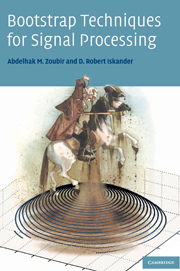5 - Real data bootstrap applications
Published online by Cambridge University Press: 03 December 2009
Summary
Chapters 3 and 4 dealt with fundamentals of bootstrap based detection and model selection, respectively. In this chapter, we provide some interesting applications of the theory covered in the former chapters to real world problems. We report only on some problems we worked on over the last years. These selected problems had been solved using classical techniques only if we had made strong assumptions which may not be valid. They are also analytically intractable.
The applications include a wide range of signal processing problems. We first report on results for optimal vibration sensor placement on spark ignition engines to detect knock. We show how the bootstrap can be used to estimate distributions of complicated statistics. Then we discuss a passive acoustic emission problem where we estimate confidence intervals for an aircraft's flight parameters. This is followed by the important problem of civilian landmine detection. We suggest an approach to detect buried landmines using a ground penetrating radar. We continue with another radar application concerning noise floor estimation in high frequency over-the-horizon radar. The chapter concludes with the estimation of the optimal model for corneal elevation in the human eye.
Optimal sensor placement for knock detection
This application illustrates the concepts discussed in Sections 3.2 and 2.2 of hypothesis testing and variance stabilisation, respectively.
- Type
- Chapter
- Information
- Bootstrap Techniques for Signal Processing , pp. 130 - 158Publisher: Cambridge University PressPrint publication year: 2004



